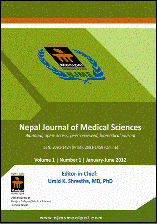An Experience of Limbal Autologous Free Conjunctival Grafting in Cases of Pterygium in Rural Western Hilly Region of Nepal
DOI:
https://doi.org/10.3126/njms.v1i1.5789Keywords:
Pterygium, limbal autologous grafting, graft retractionAbstract
Background: The study was set in a remote western hilly part of Nepal in the communities of Gulmi, Arghakhnchi and Palpa district of Nepal after seeing the high prevalence of pterygium in those communities.The main purpose of the study was to determine the outcome of free limbal autologous conjunctival grafting from supero temporal quadrant of the eyeball, in cases of pterygium undergoing surgery.
Methods: Patients undergoing surgery were evaluated preoperatively, in all cases limbal based supero temporal free autologous conjunctival graft was used, except in cases where it was contraindicated. All the patients’ data were enrolled in to a specifically made proforma for the study. Cases undergoing surgery were followed up, up to one year period. Statistical analysis was performed using Statistical Package for Social Services version 12.0 (SPSS).
Results: Hundred and fifteen eyes of 115 patients were included in the study. Ten (8.6%) cases had primary nasal and temporal pterygia both, while five (4.3%) cases in the study were recurrent pterygium. Commonest complication post operatively encountered were foreign body sensation, ocular discomfort, redness, while two cases had flap retraction which was sutured back. None of the patients had recurrence of the pterygia till the last follow up period.
Conclusion: This study has shown that free limbal based autologous conjunctival graft is one of the safe surgical techniques for Pterygium treatment with excellent outcome especially in those parts of area where modern pterygium surgery are difficult to do with various restrictions.
Keywords: Pterygium; limbal autologous grafting; graft retraction
DOI: http://dx.doi.org/10.3126/njms.v1i1.5789
Nepal Journal of Medical Sciences. 2012; 1(1): 11-14
Downloads
Downloads
How to Cite
Issue
Section
License
Copyright © by Nepal Journal of Medical Sciences. The ideas and opinions expressed by authors of articles summarized, quoted, or published in full text in this Journal represents only opinions of authors and do not necessarily reflect the official policy of Nepal Journal of Medical Sciences or the institute with which the author(s) is (are) affiliated, unless so specified.




